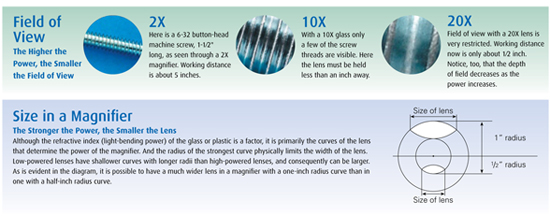 Magnifiers enlarge the image of an object so that its details may be seen more clearly. This is a function of the power of the magnifier. Three other factors affect the performance of a magnifier and its suitability for certain jobs: field of view, depth of field and working distance (focal length). The four factors are interdependent; if the power is increased, the other three become smaller, and so forth. In selecting a magnifier, you should consider all four factors. Magnifiers enlarge the image of an object so that its details may be seen more clearly. This is a function of the power of the magnifier. Three other factors affect the performance of a magnifier and its suitability for certain jobs: field of view, depth of field and working distance (focal length). The four factors are interdependent; if the power is increased, the other three become smaller, and so forth. In selecting a magnifier, you should consider all four factors.Power of Magnification The power of magnification refers to the capacity in the lens to increase the image size. X, the symbol used with a number in denoting the power of a magnifier, is quite simply the multiplication sign, “times.” Thus, a 2X magnifier creates an image size twice as large as that which the unaided eye sees at 10 inches. A 3X magnifier triples the image size, and so on. Focal Length (Working Distance) Field of View Depth of field is the distance that you can move a magnifier toward or away from an object and still have the object in focus. It also refers to the depth of the area in front of or behind the viewed object that can be seen clearly. Like the field of view, the depth of field has an inverse relationship with the power of magnification—the higher the power the shorter the depth of field.
|




